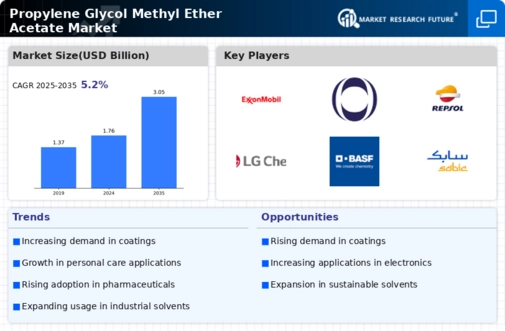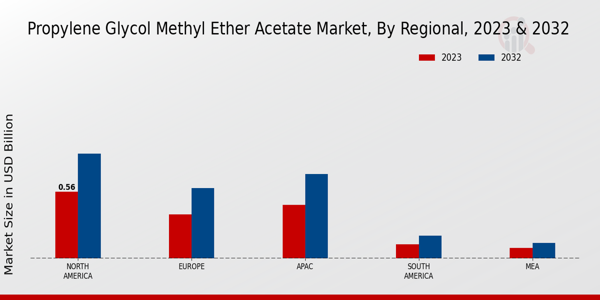Market Trends and Projections
The Global Propylene Glycol Methyl Ether Acetate Market Industry is characterized by various trends and projections that indicate its growth trajectory. The market is expected to reach 1.76 USD Billion in 2024, with a projected increase to 3.05 USD Billion by 2035. The compound annual growth rate of 5.13% from 2025 to 2035 highlights the increasing adoption of this solvent across multiple industries. Key trends include a shift towards sustainable practices, advancements in formulation technologies, and the rising demand for high-performance products. These factors collectively suggest a robust future for the market, driven by innovation and evolving consumer preferences.
Expansion in the Electronics Sector
The electronics industry significantly contributes to the Global Propylene Glycol Methyl Ether Acetate Market Industry, as this solvent is utilized in the production of electronic components. Its properties, such as low volatility and excellent solvency, make it ideal for cleaning and coating applications in electronics manufacturing. With the increasing production of consumer electronics and advancements in technology, the demand for high-purity solvents is likely to rise. This trend indicates a potential market growth trajectory, with projections suggesting a market value of 3.05 USD Billion by 2035, driven by the continuous evolution of the electronics sector.
Growing Demand in Paints and Coatings
The Global Propylene Glycol Methyl Ether Acetate Market Industry experiences a notable surge in demand from the paints and coatings sector. This chemical serves as an effective solvent, enhancing the performance and drying time of coatings. As construction and automotive industries expand, the need for high-quality coatings increases, driving market growth. In 2024, the market is projected to reach 1.76 USD Billion, reflecting the rising preference for eco-friendly and efficient solvents. The trend towards sustainable building materials and finishes further propels this demand, suggesting a robust future for propylene glycol methyl ether acetate in these applications.
Emerging Markets and Industrial Growth
The Global Propylene Glycol Methyl Ether Acetate Market Industry is poised for expansion in emerging markets, where industrial growth is accelerating. Countries in Asia-Pacific and Latin America are witnessing rapid urbanization and industrialization, leading to increased demand for solvents in various applications. This growth is driven by investments in infrastructure, automotive, and consumer goods sectors. As these regions continue to develop, the demand for propylene glycol methyl ether acetate is expected to rise significantly. The combination of industrial growth and the need for high-performance solvents suggests a promising outlook for the market in these emerging economies.
Rising Adoption in Adhesives and Sealants
The Global Propylene Glycol Methyl Ether Acetate Market Industry benefits from the growing use of this solvent in adhesives and sealants. Its ability to improve adhesion properties and enhance the performance of formulations makes it a preferred choice among manufacturers. As industries such as construction and automotive increasingly rely on advanced adhesive technologies, the demand for propylene glycol methyl ether acetate is expected to rise. This trend aligns with the projected compound annual growth rate of 5.13% from 2025 to 2035, indicating a sustained interest in high-performance adhesives that leverage this solvent's unique properties.
Regulatory Support for Eco-Friendly Solvents
The Global Propylene Glycol Methyl Ether Acetate Market Industry is positively influenced by regulatory initiatives promoting the use of eco-friendly solvents. Governments worldwide are implementing stringent regulations aimed at reducing volatile organic compounds in industrial applications. Propylene glycol methyl ether acetate, being a low-VOC solvent, aligns well with these regulations, making it an attractive option for manufacturers. This regulatory support not only enhances market acceptance but also encourages innovation in formulations that utilize this solvent. As industries adapt to these regulations, the market is likely to witness sustained growth, further solidifying its position in various applications.









